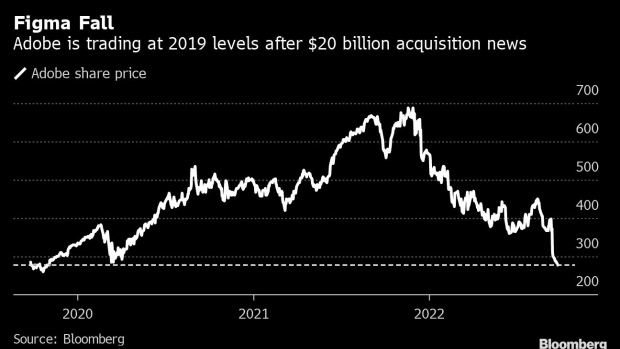Sep 28, 2022
Adobe Outlines Figma Feature Ideas, Commits to Keeping Free Tier
, Bloomberg News

(Bloomberg) -- Adobe Inc. plans to add technology from its creative software portfolio to Figma without tweaking pricing or simplicity after its acquisition, seeking to ease concerns among loyal users that the deal may significantly change the design app.
Photo, video and illustration editing will likely be implemented into the software design app after the acquisition closes, as well as the ability to link projects from Adobe products such as Photoshop or Premiere, Adobe Chief Product Officer Scott Belsky said in an interview. The company is conscious that Figma customers appreciate its simplicity, and any updates will avoid clogging up the way users maneuver around the app, he said.
Figma’s pricing model will remain “freemium,” Belsky said -- meaning that a basic tier will always be accessible without cost. “We don’t want to fix something that’s working really well.”
Adobe’s $20 billion deal to acquire startup rival Figma Inc. -- the largest takeover of a private software maker ever -- was announced earlier this month with a targeted 2023 close. The leader in creative software is looking to expand its web-based offerings to make inroads with more-casual designers and small businesses, a market that has gravitated in recent years to companies such as Figma, Canva Inc. and Lightricks Ltd.
Adobe’s XD program, which competes with Figma, will be supported for now, but the company will reevaluate once the purchase is completed, Belsky said. “XD has become a pretty immaterial product for us based on its growth and its business contribution,” Belsky said. “Once Figma comes in, we have to reevaluate where we want to shift our resources and focus.”
Belsky said these are all ideas at the moment and changes will depend on customer needs and feedback.
Figma’s streamlined browser-based design tool contrasts with Adobe’s programs, which have been increasingly seen as clunky and expensive. Many of Figma’s loyal users reacted negatively to the acquisition, fearing that Adobe would make the smaller rival less accessible and innovative. Wall Street panned the deal as too expensive and a sign that Adobe is under more competitive pressure than previously appreciated.
The uproar feels familiar to Belsky, who joined Adobe via acquisition of the company he co-founded, Behance, almost a decade ago. Negative Twitter posts about that deal mirror what’s being said about Adobe buying Figma now, Belsky said.
“I understand why customers are always afraid of change,” Belsky said. “But when you have the right people that are really aligned with the same principles and recognize the value of what’s being brought in, sometimes it really turns out magnificently.” He added that Behance’s user base is 30 times the size it was when bought by Adobe.
File sharing without additional licensing costs helped fuel Figma’s rapid adoption, and Belsky said this dynamic won’t be changed. Users won’t need to have a Creative Cloud subscription to work on a document, he said.
Figma co-founder and Chief Executive Officer Dylan Field said he recognizes that users fear innovation will slow down after an acquisition, but he hopes the company can actually accelerate improvements to the platform with new technology and expertise at Adobe. “I think it’s good for the community,” he said in an interview. “That’s what I intend to prove.”
Adobe’s massive library of fonts and stock images, along with new media-editing features in the browser, will make working in Figma more efficient, Field said. Plus, Adobe has troves of usage data that can inform what tech is most important to port over.
He echoed Belsky that there are no price increases planned, that Figma will always be fully free for education and that he is “very committed” to maintaining a free tier, which fuels adoption.
Field said he will continue to focus his attention on Figma after the deal is completed, although he’ll provide advice to Adobe. InDesign is one product he thinks would particularly benefit from more-collaborative workflows.
Belsky said the rest of Adobe’s portfolio will take cues from Figma on collaborative updates. Its multiplayer web platform may be adopted for Adobe’s other creative offerings, and its FigJam whiteboarding and presentation capabilities may be integrated into Adobe Express and Acrobat, Belsky said.
“We would only want to amplify and continue and learn from the things that Figma has done to become a viral product in the enterprise and throughout the world,” Belsky said.
©2022 Bloomberg L.P.





